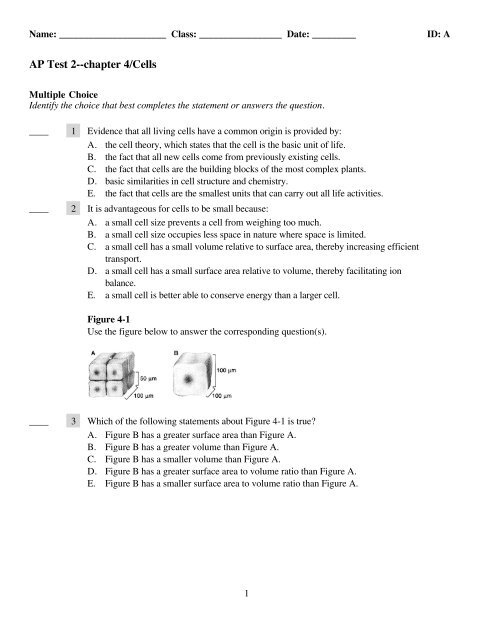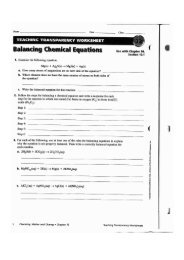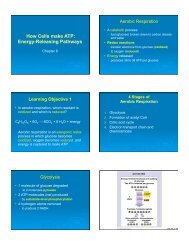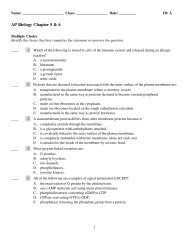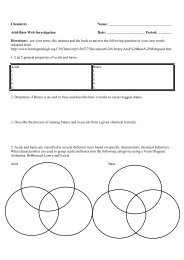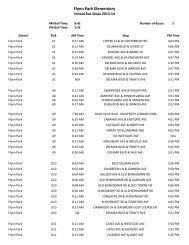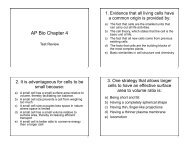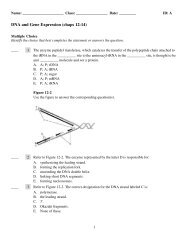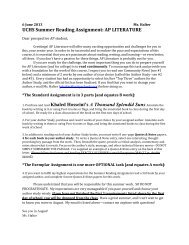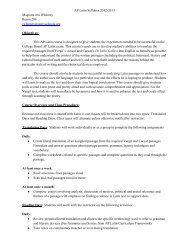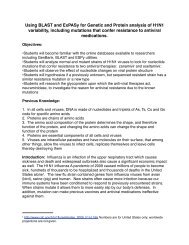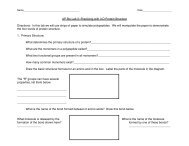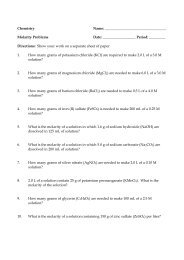AP Test 2--chapter 4/Cells - University City Schools
AP Test 2--chapter 4/Cells - University City Schools
AP Test 2--chapter 4/Cells - University City Schools
Create successful ePaper yourself
Turn your PDF publications into a flip-book with our unique Google optimized e-Paper software.
Name: ______________________ Class: _________________ Date: _________<br />
ID: A<br />
<strong>AP</strong> <strong>Test</strong> 2--<strong>chapter</strong> 4/<strong>Cells</strong><br />
Multiple Choice<br />
Identify the choice that best completes the statement or answers the question.<br />
____<br />
____<br />
1 Evidence that all living cells have a common origin is provided by:<br />
A. the cell theory, which states that the cell is the basic unit of life.<br />
B. the fact that all new cells come from previously existing cells.<br />
C. the fact that cells are the building blocks of the most complex plants.<br />
D. basic similarities in cell structure and chemistry.<br />
E. the fact that cells are the smallest units that can carry out all life activities.<br />
2 It is advantageous for cells to be small because:<br />
A. a small cell size prevents a cell from weighing too much.<br />
B. a small cell size occupies less space in nature where space is limited.<br />
C. a small cell has a small volume relative to surface area, thereby increasing efficient<br />
transport.<br />
D. a small cell has a small surface area relative to volume, thereby facilitating ion<br />
balance.<br />
E. a small cell is better able to conserve energy than a larger cell.<br />
Figure 4-1<br />
Use the figure below to answer the corresponding question(s).<br />
____<br />
3 Which of the following statements about Figure 4-1 is true?<br />
A. Figure B has a greater surface area than Figure A.<br />
B. Figure B has a greater volume than Figure A.<br />
C. Figure B has a smaller volume than Figure A.<br />
D. Figure B has a greater surface area to volume ratio than Figure A.<br />
E. Figure B has a smaller surface area to volume ratio than Figure A.<br />
1
Name: ______________________<br />
ID: A<br />
____<br />
____<br />
____<br />
____<br />
____<br />
____<br />
4 Based on your knowledge of basic geometric relationships, the actual surface area to volume ratio<br />
for Figure B in Figure 4-1 is:<br />
A. 0.01.<br />
B. 0.06.<br />
C. 100.<br />
D. 1,000.<br />
E. This cannot be determined from the information provided.<br />
5 One strategy that allows larger cells to have an effective surface area to volume ratio is:<br />
A. having a completely spherical shape.<br />
B. being short and fat.<br />
C. having thin, finger-like projections.<br />
D. having a thinner plasma membrane.<br />
E. locomotion.<br />
6 The ratio of the size of the image seen with the microscope to the actual size of the object is called:<br />
A. magnification.<br />
B. resolution.<br />
C. resolving power.<br />
D. centrifugation.<br />
E. fractionation.<br />
7 Differential centrifugation is a process that:<br />
A. separates different components based on function.<br />
B. separates components of the cell based on chemistry.<br />
C. analyzes the chemical components of the cell.<br />
D. separates components of the cell based on densities.<br />
E. allows researchers to see inside of a cell.<br />
8 A eukaryotic cell:<br />
A. is usually smaller than a prokaryotic cell.<br />
B. has its DNA concentrated in one area of the cell without a nuclear membrane.<br />
C. typically has a cell wall, in addition to a plasma membrane.<br />
D. is exemplified by bacteria.<br />
E. has a variety of membranous organelles.<br />
9 Membrane-bounded organelles facilitate faster chemical reactions because:<br />
A. reactants are within close proximity to each other.<br />
B. membranes lower the activation energy of biochemical reactions.<br />
C. membrane-bounded organelles act as catalysts for biochemical reactions.<br />
D. reactants move faster within membrane-bounded organelles.<br />
E. reactants are less likely to encounter each other within membrane-bounded<br />
organelles.<br />
2
Name: ______________________<br />
ID: A<br />
____<br />
____<br />
____<br />
____<br />
____<br />
____<br />
10 Which of the following structures or activities is NOT directly part of the endomembrane system?<br />
A. budding<br />
B. lysosomes<br />
C. ribosomes<br />
D. peroxisomes<br />
E. Golgi complex<br />
11 DNA is associated with proteins, forming a complex called:<br />
A. chromosomes.<br />
B. nucleoli.<br />
C. nucleus.<br />
D. genes.<br />
E. chromatin.<br />
12 Nucleoli (singular-nucleolus) contain chromosomal regions that specialize in making:<br />
A. proteins.<br />
B. RNA for the building of ribosomes.<br />
C. basal bodies.<br />
D. lipids.<br />
E. hormones.<br />
13 A single cell in a smoker's lung has become cancerous. It doubles its DNA and divides much faster<br />
than a normal lung cell. The most likely change that would have caused this condition took place in<br />
the:<br />
A. nucleus.<br />
B. nucleolus.<br />
C. microtubule.<br />
D. mitochondria.<br />
E. lysosome.<br />
14 If a toxin, such as a bacterial toxin, destroys ribosomes, what cellular activity will be affected first?<br />
A. protein synthesis<br />
B. DNA synthesis<br />
C. movement<br />
D. energy storage<br />
E. active transport<br />
15 The smooth endoplasmic reticulum:<br />
A. is absent in most plant cells.<br />
B. synthesizes proteins.<br />
C. provides structural support.<br />
D. synthesizes lipids.<br />
E. is required for ribosome synthesis.<br />
3
Name: ______________________<br />
ID: A<br />
Figure 4-2<br />
Use the figure to answer the corresponding question(s).<br />
____<br />
____<br />
____<br />
____<br />
16 Refer to Figure 4-2. The cellular structure indicated by the arrow is responsible for:<br />
A. lipid and fatty acid metabolism.<br />
B. protein synthesis.<br />
C. digestion of unused organelles.<br />
D. replication.<br />
E. None of these.<br />
17 Which of the following functions would most likely be occurring in the structure surrounded by<br />
the box in Figure 4-2?<br />
A. apoptosis<br />
B. dynein movement<br />
C. formation of hydrogen peroxide<br />
D. protein modification<br />
E. cholesterol synthesis<br />
18 Proteins made on ribosomes may be further modified within the:<br />
A. lysosomes.<br />
B. nucleus.<br />
C. mitochondria.<br />
D. Golgi complex.<br />
E. peroxisomes.<br />
19 The cis face (closest to nucleus) of the Golgi complex is most directly involved in which of the<br />
following?<br />
A. packaging molecules in vesicles<br />
B. accepting vesicles from the ER<br />
C. synthesizing proteins<br />
D. transporting molecules out of the Golgi<br />
E. catalyzing the efficient folding of proteins<br />
4
Name: ______________________<br />
ID: A<br />
____<br />
____<br />
____<br />
____<br />
____<br />
20 The __________ can be considered a sorting, processing and packaging center.<br />
A. centriole<br />
B. centrosome<br />
C. Golgi complex<br />
D. vacuole<br />
E. cytoskeleton<br />
21 During an infection, white blood cells travel to the infected site and phagocytize the pathogens.<br />
After phagocytosis, primary lysosomes fuse with the phagocytic vesicle to form a larger vesicle<br />
called a secondary lysosome. The reason for this is:<br />
A. to introduce antibodies to the phagocytic vesicles.<br />
B. to wrap the pathogen in additional membrane, rendering them harmless.<br />
C. to coat the bacteria in lipids derived from the Golgi complex, which cover and<br />
smother them.<br />
D. to mix the pathogens with strong hydrolytic enzymes and destroy them.<br />
E. to prepare the bacteria for export from the body.<br />
22 All of the following functions are performed by plant vacuoles EXCEPT:<br />
A. maintaining hydrostatic (turgor) pressure.<br />
B. waste storage and recycling.<br />
C. storage of proteins.<br />
D. breakdown of unneeded cellular materials.<br />
E. storage of nucleic acids.<br />
23 One function of peroxisomes involves the process of:<br />
A. cell death.<br />
B. water storage.<br />
C. protein synthesis.<br />
D. DNA replication.<br />
E. detoxification.<br />
24 The theory that chloroplasts and mitochondria had their evolutionary beginnings in eukaryotic cells<br />
as endosymbionts is supported by all of the following EXCEPT:<br />
A. chloroplasts and mitochondria are completely autonomous within eukaryotic cells.<br />
B. chloroplasts and mitochondria have DNA.<br />
C. chloroplasts and mitochondria have small ribosomes for protein synthesis.<br />
D. chloroplasts and mitochondria are approximately the same size as prokaryotic cells.<br />
E. chloroplasts and mitochondria have the same shape as prokaryotic cells.<br />
5
Name: ______________________<br />
ID: A<br />
Figure 4-3<br />
Use the figure to answer the corresponding question(s).<br />
____ 25 The organelle featured in Figure 4-3:<br />
A. is present in a few prokaryotes.<br />
B. is the major site of protein synthesis in the cell.<br />
C. plays a vital role in packaging materials to be secreted.<br />
D. plays a central role in energy metabolism.<br />
E. is located in the nucleus.<br />
____<br />
____<br />
____<br />
____<br />
26 The structures indicated by the arrows in Figure 4-3 are:<br />
A. intermembrane space.<br />
B. grana.<br />
C. cristae.<br />
D. matrices.<br />
E. plastids.<br />
27 The main process that occurs at the site of the structures marked by arrows in Figure 4-3 is:<br />
A. protein synthesis.<br />
B. photosynthesis.<br />
C. conversion of food molecules to ATP.<br />
D. processing and packaging of proteins.<br />
E. transcription.<br />
28 Which of the following organelles plays an important role in apoptosis, or programmed cell death?<br />
A. ribosomes<br />
B. mitochondria<br />
C. chloroplasts<br />
D. vacuoles<br />
E. peroxisomes<br />
29 A cellular structure found in plant but not animal cells is the:<br />
A. chloroplast.<br />
B. ribosome.<br />
C. endoplasmic reticulum.<br />
D. microtubule.<br />
E. microfilament.<br />
6
Name: ______________________<br />
ID: A<br />
Figure 4-4<br />
Use the figure to answer the corresponding question(s).<br />
____<br />
30 Refer to Figure 4-4. If you treated this organelle to remove ONLY the chlorophyll, which label<br />
indicates the portion of the organelle that would be most directly affected by this treatment?<br />
A. A (stroma)<br />
B. B (outer membrane)<br />
C. C (inner membrane)<br />
D. D (thylakoid)<br />
E. E (granum)<br />
____ 31 The formation of carbohydrates from carbon dioxide and water occurs in the portion of Figure 4-4<br />
labeled:<br />
A. A (stroma)<br />
B. B (outer membrane)<br />
C. C (inner membrane)<br />
D. D (thylakoid)<br />
E. E (granum)<br />
____<br />
____<br />
32 Which of the following structures would not be found in cells of a plant's roots?<br />
A. mitochondria<br />
B. chloroplasts<br />
C. endoplasmic reticulum<br />
D. nucleus<br />
E. Golgi complex<br />
33 Which of the following is a key component of the cytoskeleton?<br />
A. centrosome<br />
B. microtubules<br />
C. DNA<br />
D. ribosomes<br />
E. endoplasmic reticulum<br />
7
Name: ______________________<br />
ID: A<br />
____<br />
____<br />
____<br />
____<br />
34 Which of the following pairs is correctly matched?<br />
A. chloroplast!storage of enzymes<br />
B. lysosome!powerhouse of the cell<br />
C. centrosome!cell division<br />
D. plastids!structural support of the cell<br />
E. Golgi complex!production of energy<br />
35 Which of the following is/are not associated with mitochondria?<br />
A. cristae<br />
B. aerobic respiration<br />
C. apoptosis<br />
D. free radicals<br />
E. thylakoids<br />
36 Which of the following statements concerning centrioles is FALSE?<br />
A. They are present in most animal cells but not most plant cells.<br />
B. They are duplicated before cell division.<br />
C. They have a 9 + 2 arrangement of microtubules.<br />
D. They are found in the nucleus.<br />
E. They are thought to play a role in microtubule assembly.<br />
37 The structures in the micrograph are:<br />
____<br />
A. chloroplasts.<br />
B. cilia.<br />
C. rough ER.<br />
D. flagella.<br />
E. B or D.<br />
38 Which of the following is NOT a cell covering or part of a cell covering?<br />
A. glycocalyx<br />
B. extracellular matrix<br />
C. cristae<br />
D. cell wall<br />
E. integrins<br />
8
Name: ______________________<br />
ID: A<br />
____<br />
____<br />
39 A plasma membrane is characteristic of:<br />
A. all cells. D. animal cells only.<br />
B. prokaryotic cells only. E. eukaryotic cells except plant cells.<br />
C. eukaryotic cells only.<br />
40 In eukaryotic cells, DNA is found in:<br />
A. chromosomes. D. a, b, and c.<br />
B. chromatin. E. a and b.<br />
C. mitochondria.<br />
Short Answer<br />
41 Compare and contrast prokaryotes and eukaryotes. Feel free to use diagrams in your explanation.<br />
42 Discuss the benefits of compartmentalization. Be as specific as possible, using examples to best<br />
support your answer.<br />
9
Name: ______________________<br />
ID: A<br />
Multiple Response<br />
Identify one or more choices that best complete the statement or answer the question.<br />
____ 43<br />
Write the letters in the boxes, next to the numbers to label the parts of this cell. ON LINE 43,<br />
WRITE ANIMAL OR PLANT.<br />
A. mitochondrion E. chromatin<br />
B. nuclear envelope F. nucleolus<br />
C. plasma membrane G. centriole<br />
D. golgi body H. lysosome<br />
10
Name: ______________________<br />
ID: A<br />
____ 44<br />
Write the letters in the boxes, next to the numbers to label the parts of this cell. ON LINE 43,<br />
WRITE ANIMAL OR PLANT.<br />
A. chromatin E. mitochondrion<br />
B. chloroplast F. vacuole<br />
C. cell wall G. golgi body<br />
D. plasma membrane H. nucleolus<br />
11
ID: A<br />
<strong>AP</strong> <strong>Test</strong> 2--<strong>chapter</strong> 4/<strong>Cells</strong><br />
Answer Section<br />
MULTIPLE CHOICE<br />
1 ANS: D<br />
2 ANS: C<br />
3 ANS: E<br />
4 ANS: B<br />
5 ANS: C<br />
6 ANS: A<br />
7 ANS: D<br />
8 ANS: E<br />
9 ANS: A<br />
10 ANS: C<br />
11 ANS: E<br />
12 ANS: B<br />
13 ANS: A<br />
14 ANS: A<br />
15 ANS: D<br />
16 ANS: B<br />
17 ANS: D<br />
18 ANS: D<br />
19 ANS: B<br />
20 ANS: C<br />
21 ANS: D<br />
22 ANS: E<br />
23 ANS: E<br />
24 ANS: A<br />
25 ANS: D<br />
26 ANS: C<br />
27 ANS: C<br />
28 ANS: B<br />
1
ID: A<br />
29 ANS: A<br />
30 ANS: D<br />
31 ANS: A<br />
32 ANS: B<br />
33 ANS: B<br />
34 ANS: C<br />
35 ANS: E<br />
36 ANS: C<br />
37 ANS: E<br />
38 ANS: C<br />
39 ANS: A<br />
40 ANS: D<br />
SHORT ANSWER<br />
41 ANS:<br />
Answer not provided.<br />
42 ANS:<br />
Answer will vary.<br />
MULTIPLE RESPONSE<br />
43 ANS: A, B, C, D, E, F, G, H<br />
44 ANS: A, B, C, D, E, F, G, H<br />
2


